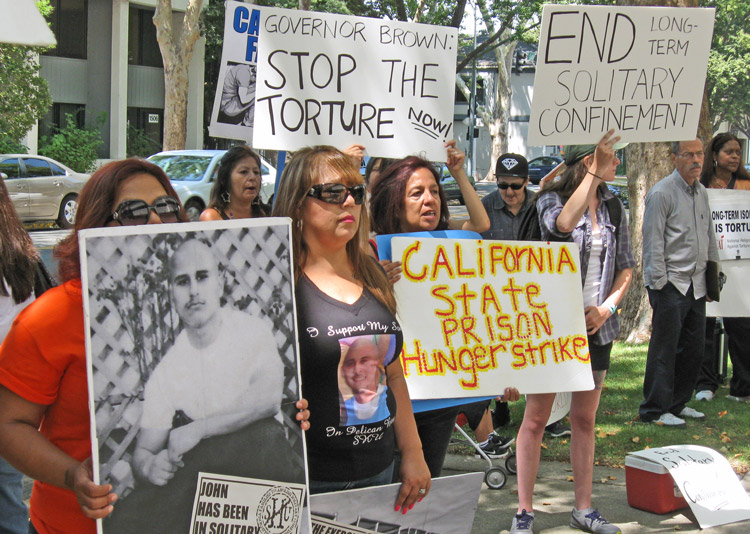“The Strike,” a documentary, directed by JoeBill Muñoz and Lucas Guilkey.
OAKLAND, Calif. — I was glad to see that “The Strike,” a film about the 2013 prison hunger strike in California was aired on the PBS program Independent Lens Feb. 3.
This fight, which involved more than 30,000 prisoners at the high point, is one that needs to be known. It is an example of how, with leadership, working people — including those behind bars — can unite and make history, transforming ourselves in the process.
The strike was part of a multiyear struggle that ended long-term, indefinite solitary confinement in California. It led to many held in solitary being released into the general prison population, and for some to be freed.
In 2013, it was not well known that over 4,000 prisoners in California were being held in indefinite solitary confinement, many for decades. The hunger strike changed that. It put a spotlight on the barbarity involved, what it meant to put human beings in tiny concrete cages for years almost devoid of human interaction, with little or no perspective of getting out.
The film takes you inside the Pelican Bay State Prison in the far north of California where prisoners were locked in Security Housing Units called the SHU. You see the tiny 8-by-10-foot windowless cells. You also learn how the prisoners resisted, organizing a strike that spread from prison to prison.
Supporters of the hunger strike outside the prisons backed up the fight inside. The film features the organizing efforts of Dolores Canales, a Los Angeles leader of California Families to Abolish Solitary Confinement, whose son was in Pelican Bay. You see footage of the many protests spearheaded by the families, former prisoners and others.
Film based on interviews
The film is based on interviews with participants in the strike, who describe their lives in solitary, how they fought to not be broken, how they were empowered and transformed by the struggle.
But I was disappointed the film didn’t make clear the decisive role of the central leaders of the fight from Pelican Bay. Four prisoners, one Black, one white and two Latinos, worked to unite prisoners around clear demands, negotiated with prison authorities and helped organize a broader group of prisoner representatives to participate in decision-making. Those like myself, part of the support movement on the outside, were inspired by what these leaders did and said.
Overcoming gang and other rivalries used by their jailers to divide and rule was fundamental to success. As Todd Ashker, one of the four, explained, “Our current collective movement began in the bowels of the Pelican Bay State Prison — SHU — Short Corridor, wherein prisoners of all races and various geographical areas became openly conscious of what we had in common — rather than what was different.”
While Ashker remains behind bars, another of the central leaders, Sitawa Nantambu Jamaa, is now free. When he spoke in Oakland at one of the first showings of the film, he stressed the importance of the “Agreement to End Race-Based Hostilities,” signed onto by white, Black and Latino prisoners in 2012. This agreement, undercutting attempts by prison authorities to pit racial groups against one another, was a precondition for carrying out a united fight.
A high point of the film is footage of negotiations between these four leaders and a prison representative in 2011. You see how the collective action of the strikers gave them confidence.
Long fight makes progress
The 2013 hunger strike was called off after 60 days, when legislators in Sacramento promised public hearings. They took place, and family members, ex-prisoners and others testified, but the state legislature didn’t meet the prisoners’ demands. Democratic Party Gov. Jerry Brown opposed the strike and backed the prison authorities.
A breakthrough came in 2015, when a lawsuit, Ashker v. Governor of California, brought by the Pelican Bay prisoners was settled. The agreement said solitary confinement could only be imposed for specific acts and for a fixed length of time, a significant victory.
Before the settlement, inmates could be “validated” by prison authorities as gang members and put in the SHU merely on the basis of a supposedly gang-related tattoo, possession of a book, letter or piece of art, or the words of other prisoners. Review for possible release took place only once every six years. In order to get out of the SHU, you had to “debrief,” that is finger others as gang members — a practice calculated to dehumanize and increase division and violence among prisoners.
As struggles continued to get the agreement implemented in the following years, the Pelican Bay SHU was nearly emptied out.
The Pelican Bay prisoners were inspired by a book about Irish independence fighter Bobby Sands, who died in a 1981 hunger strike. Opposing the prison authorities attempts to block books and newspapers, including the San Francisco Bay View, Prison Focus and the Militant that carried news of the struggle, from getting into the prisons was an important part of the fight.
At the press conference announcing the settlement, a statement released by Jamaa and nine other prisoner-plaintiffs was read by Jamaa’s sister, Marie Levin. “We recognize that achieving our goal of fundamentally transforming the criminal justice system and stopping the practice of warehousing people in prison will be a protracted struggle,” it said. “We are fully committed to that effort and invite you to join us.”
“The Strike,” can be viewed for free on the PBS Independent Lens website.


